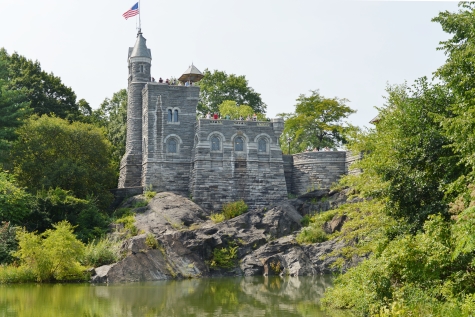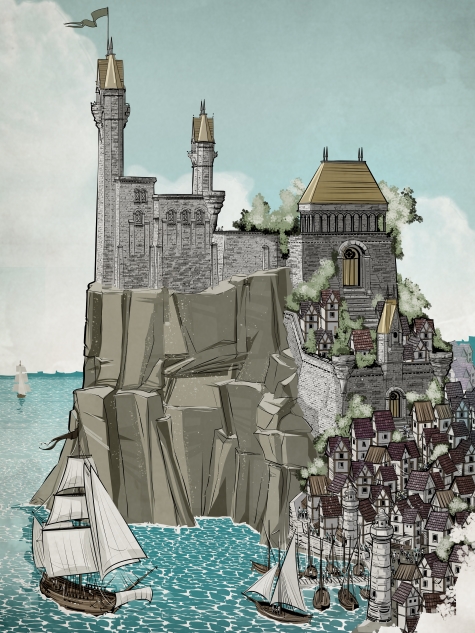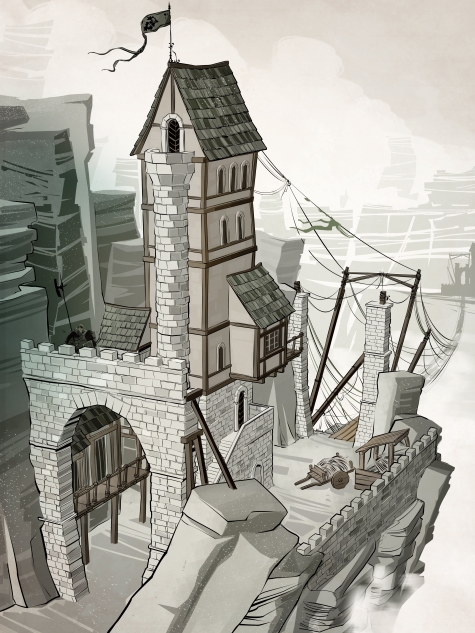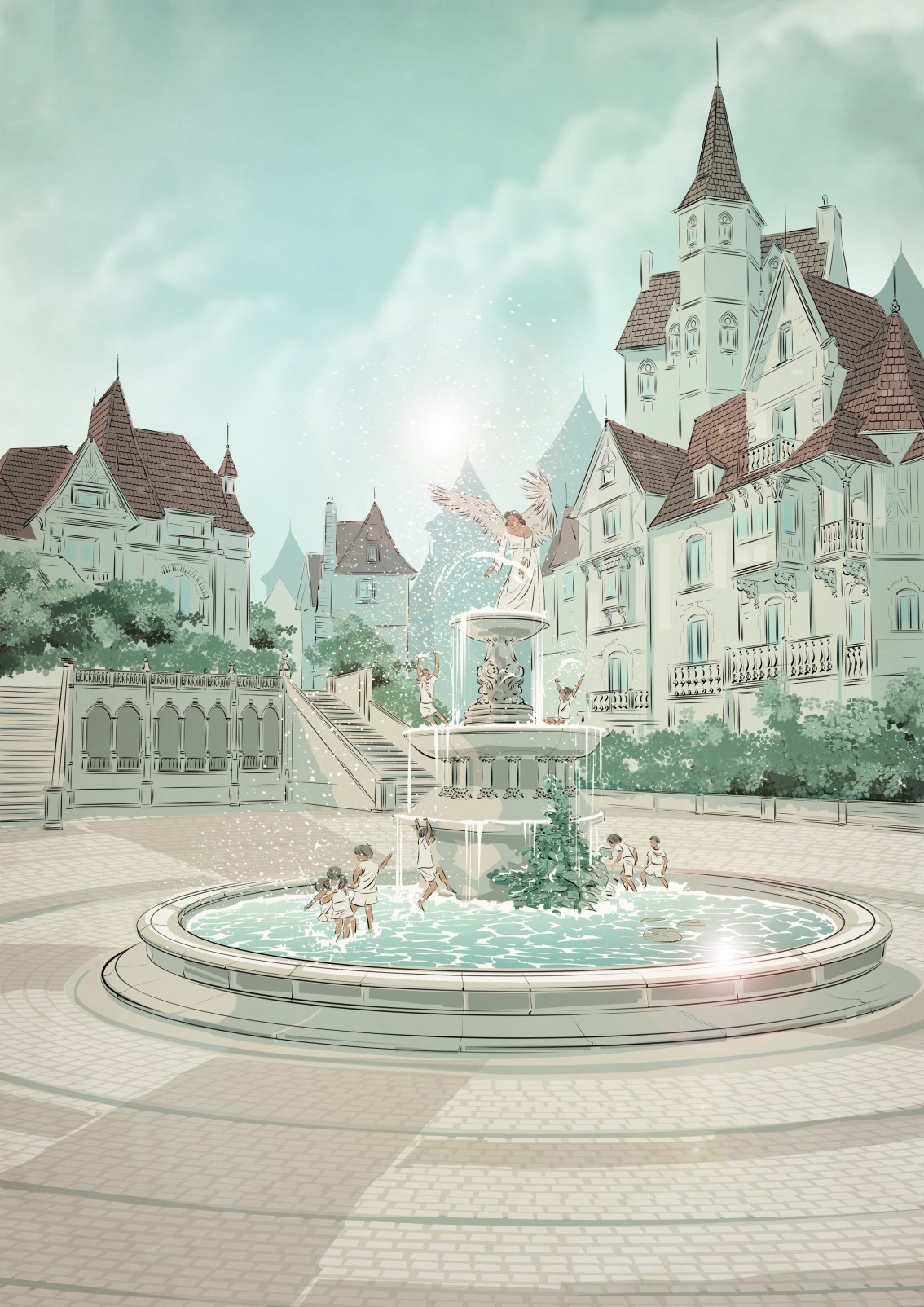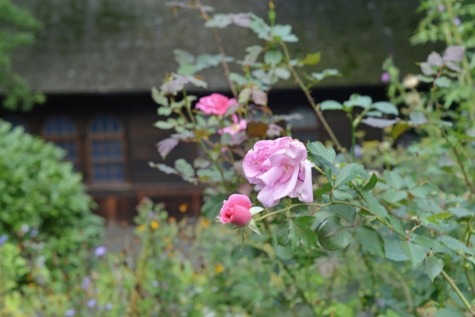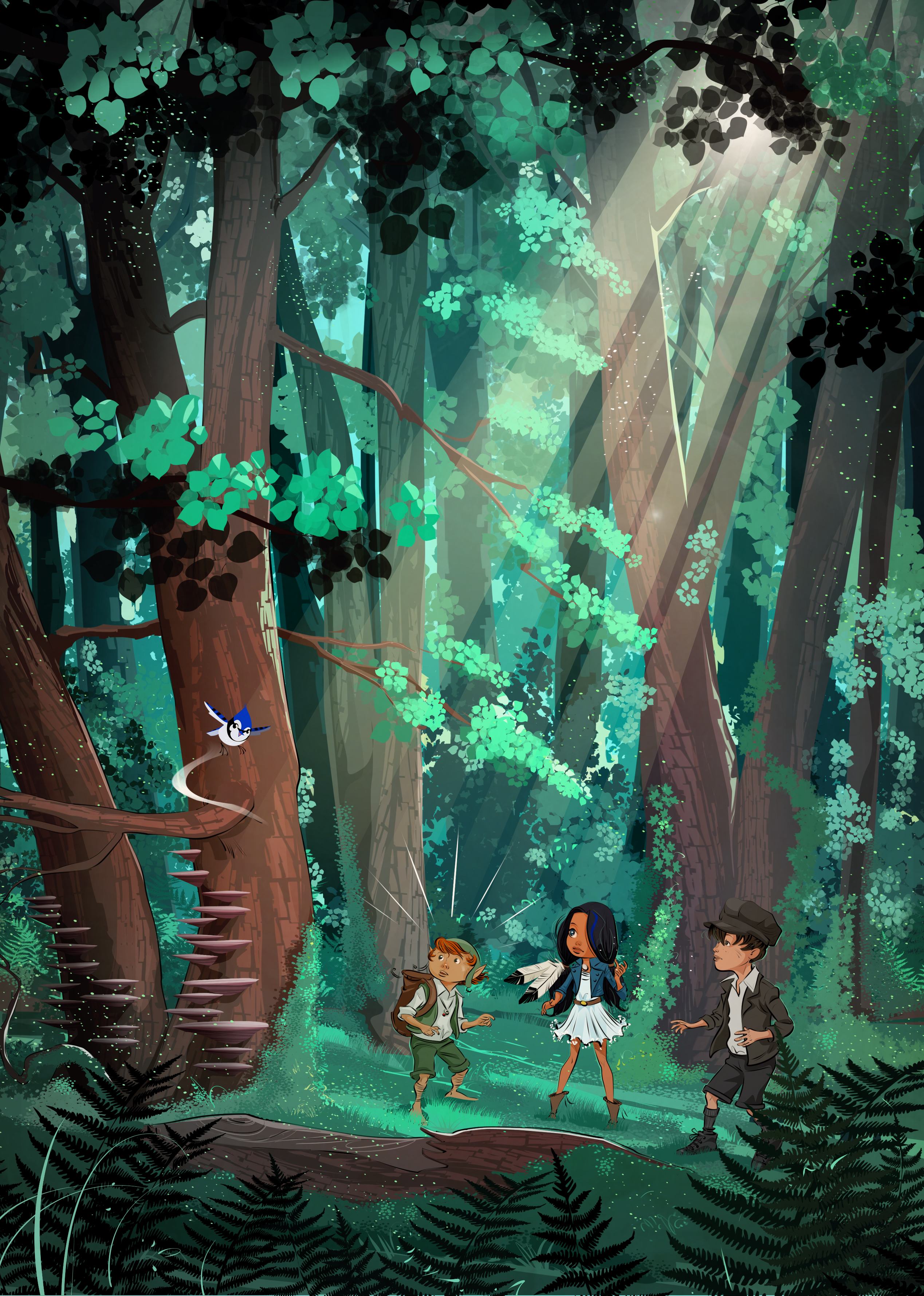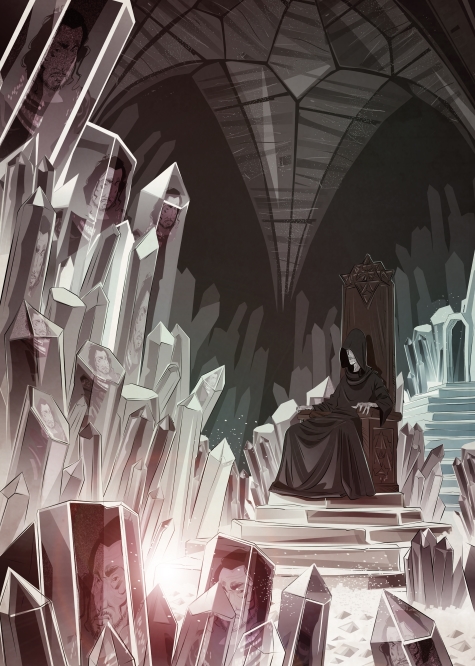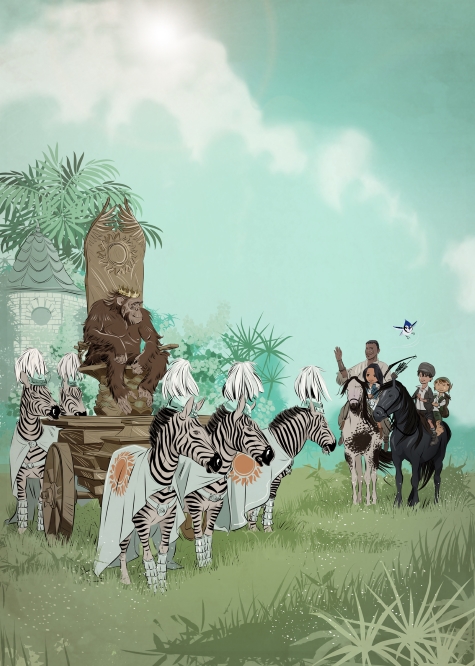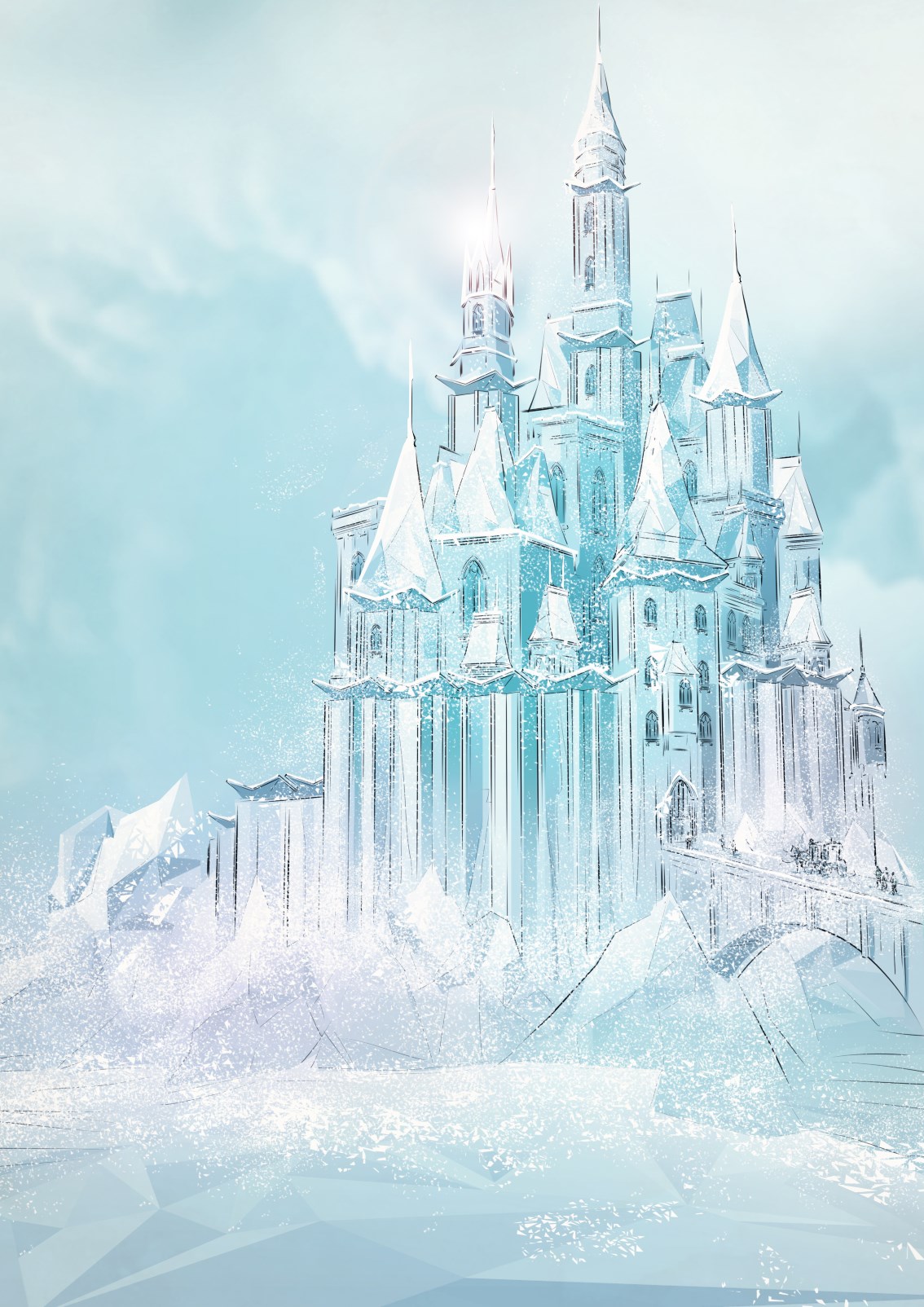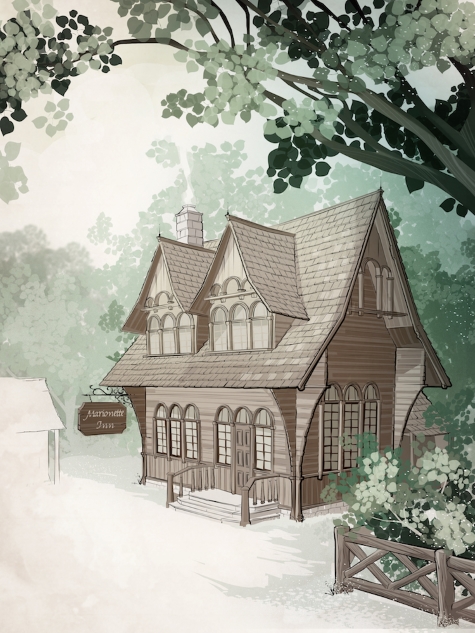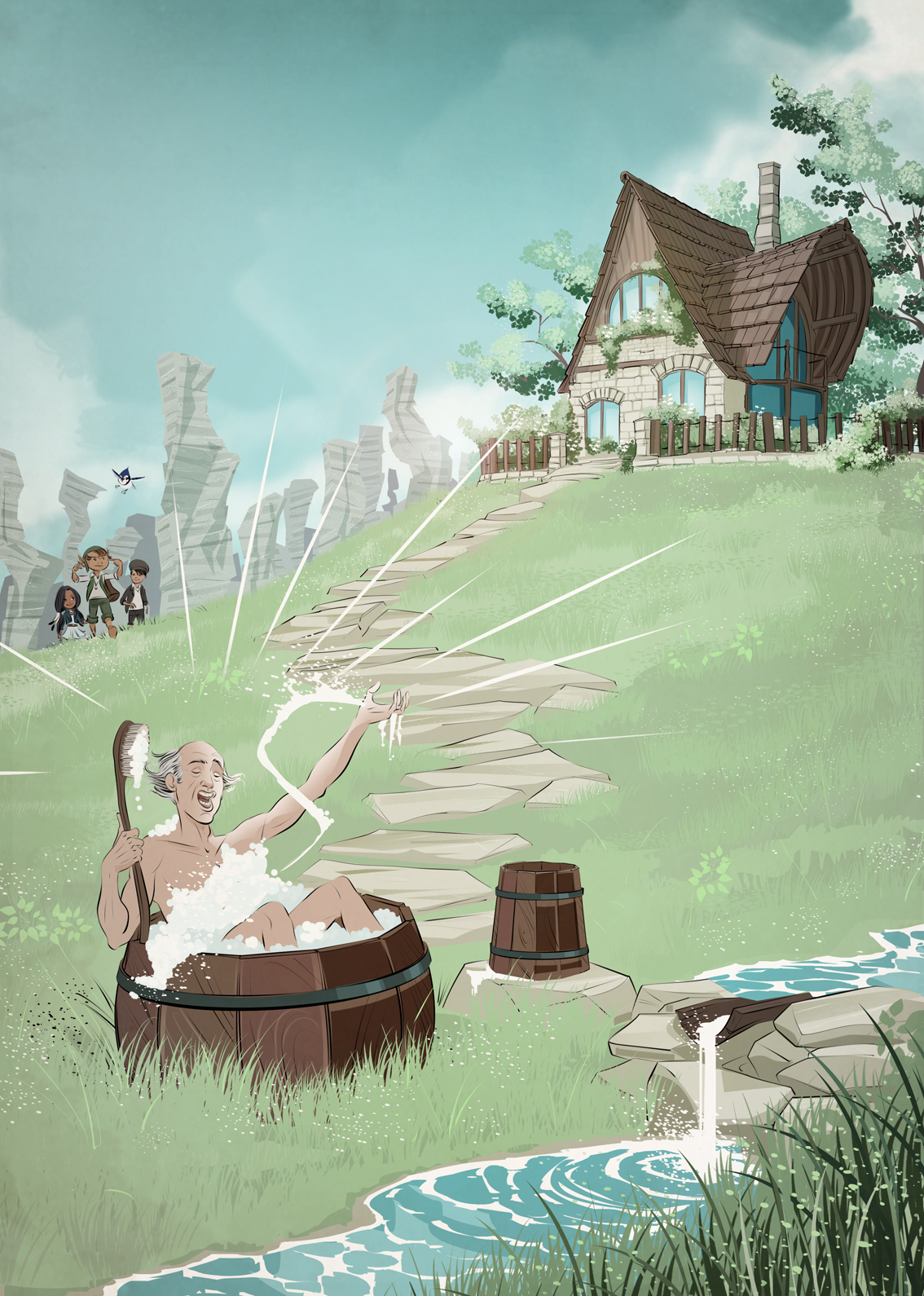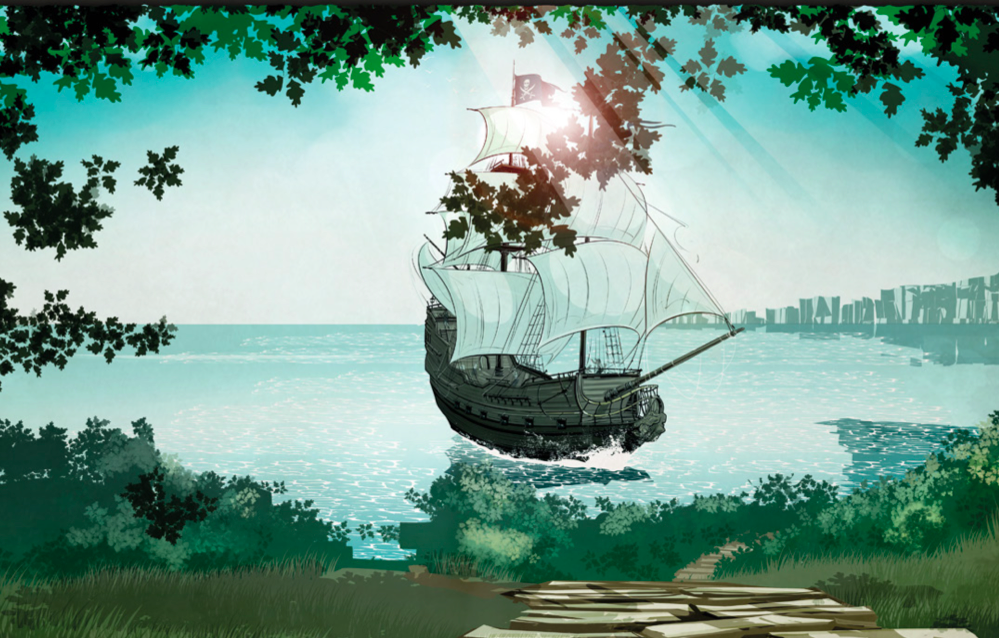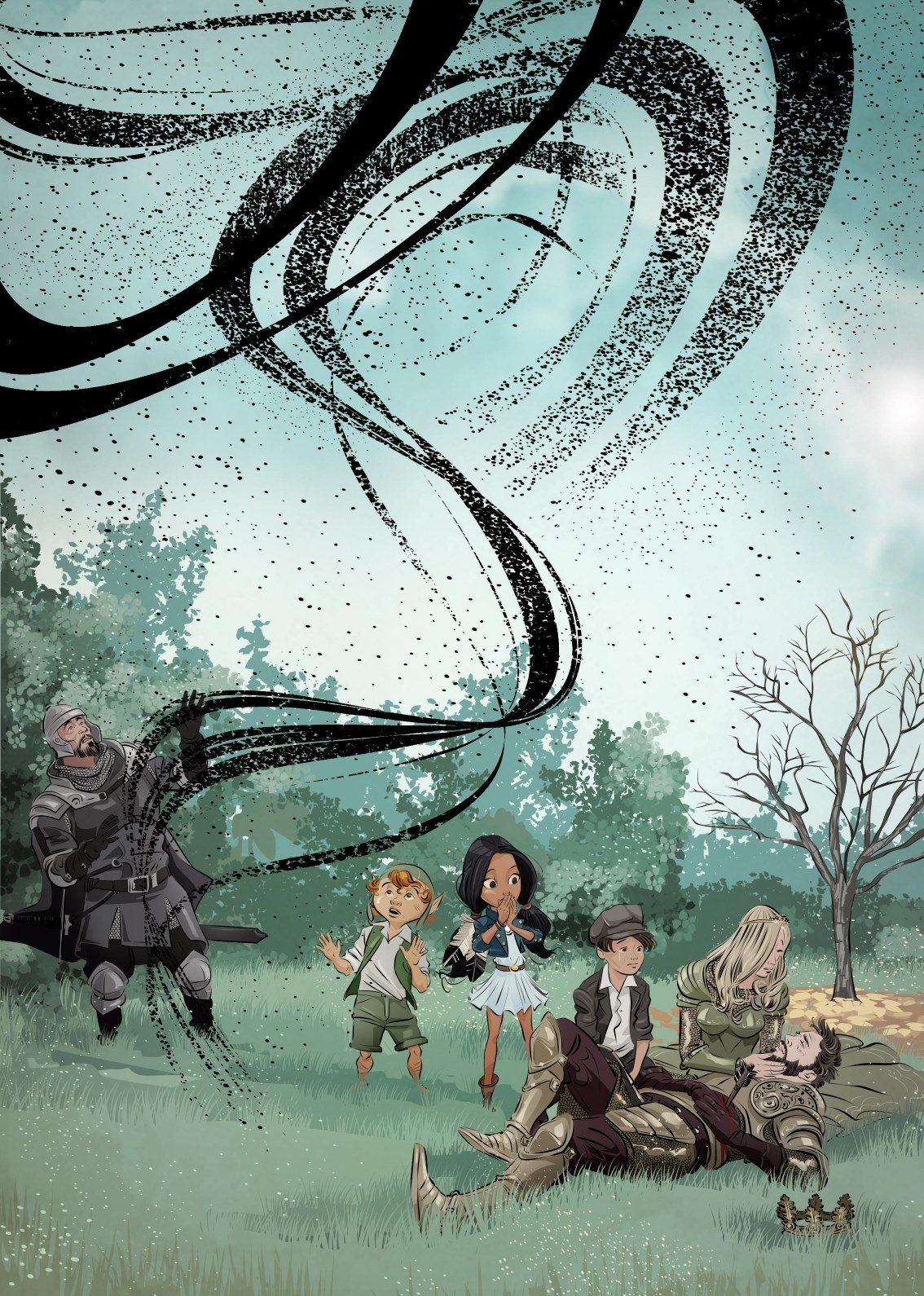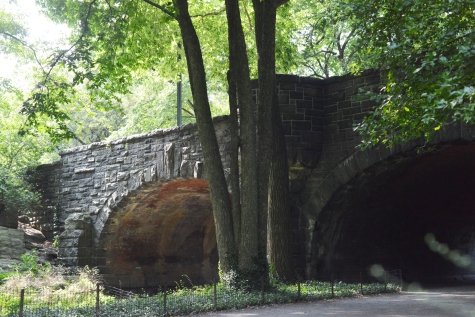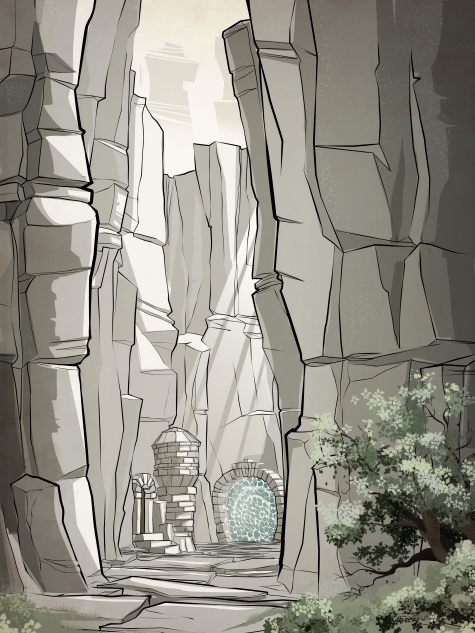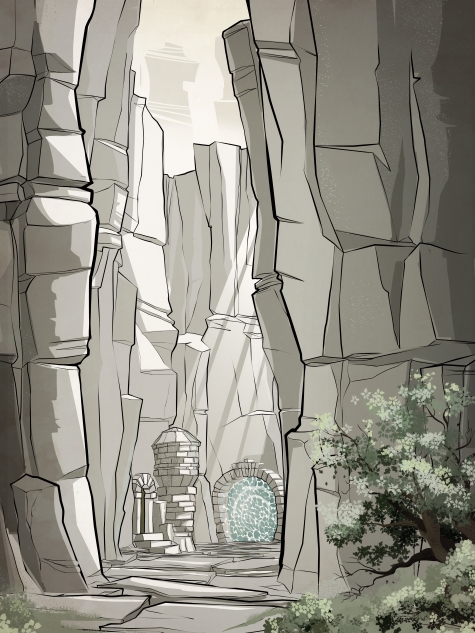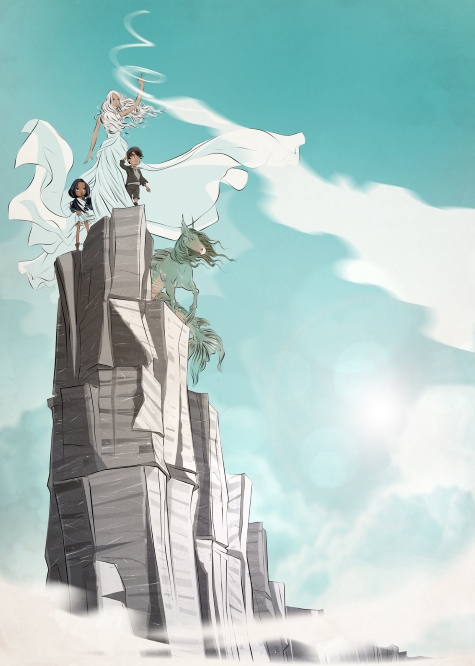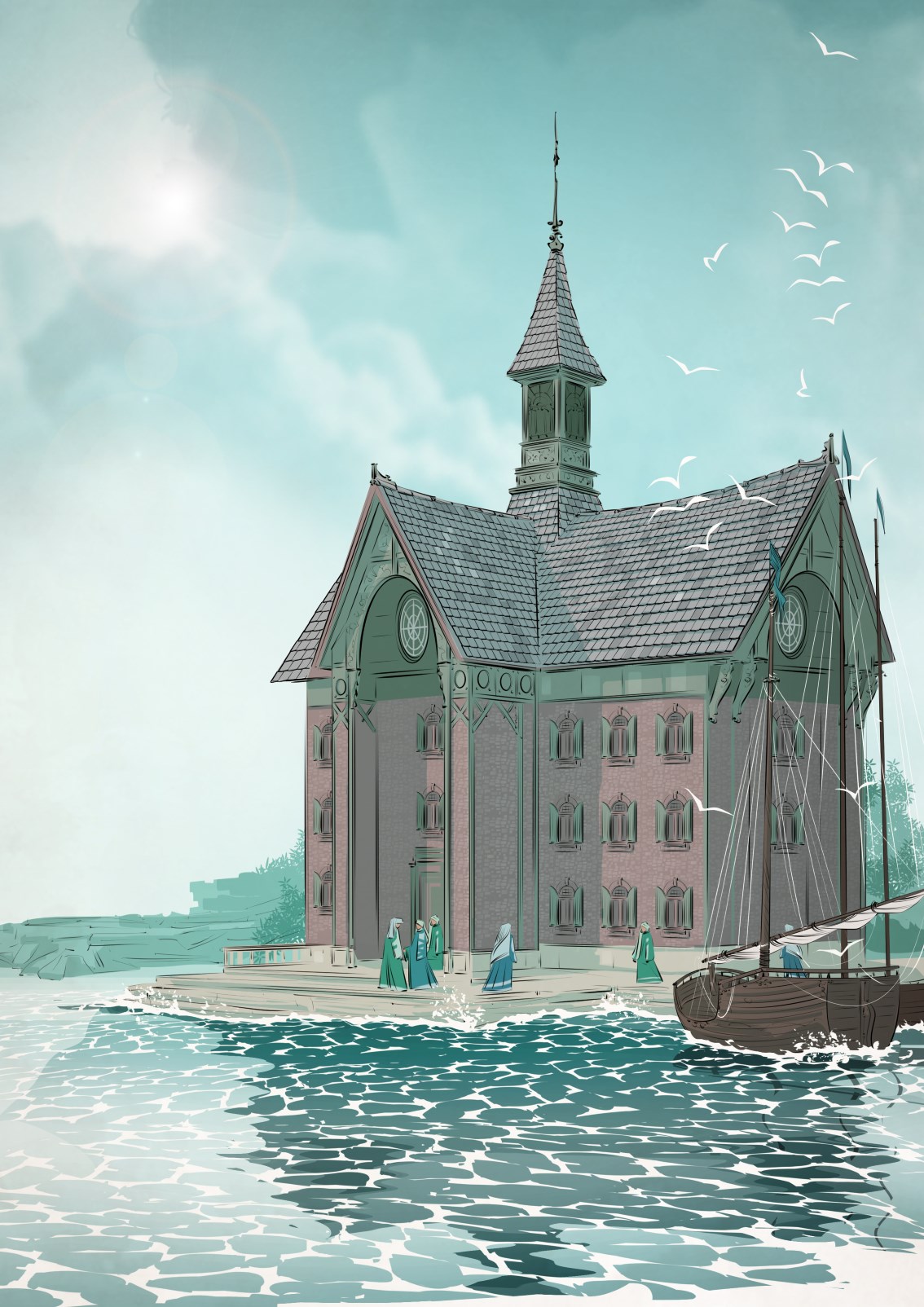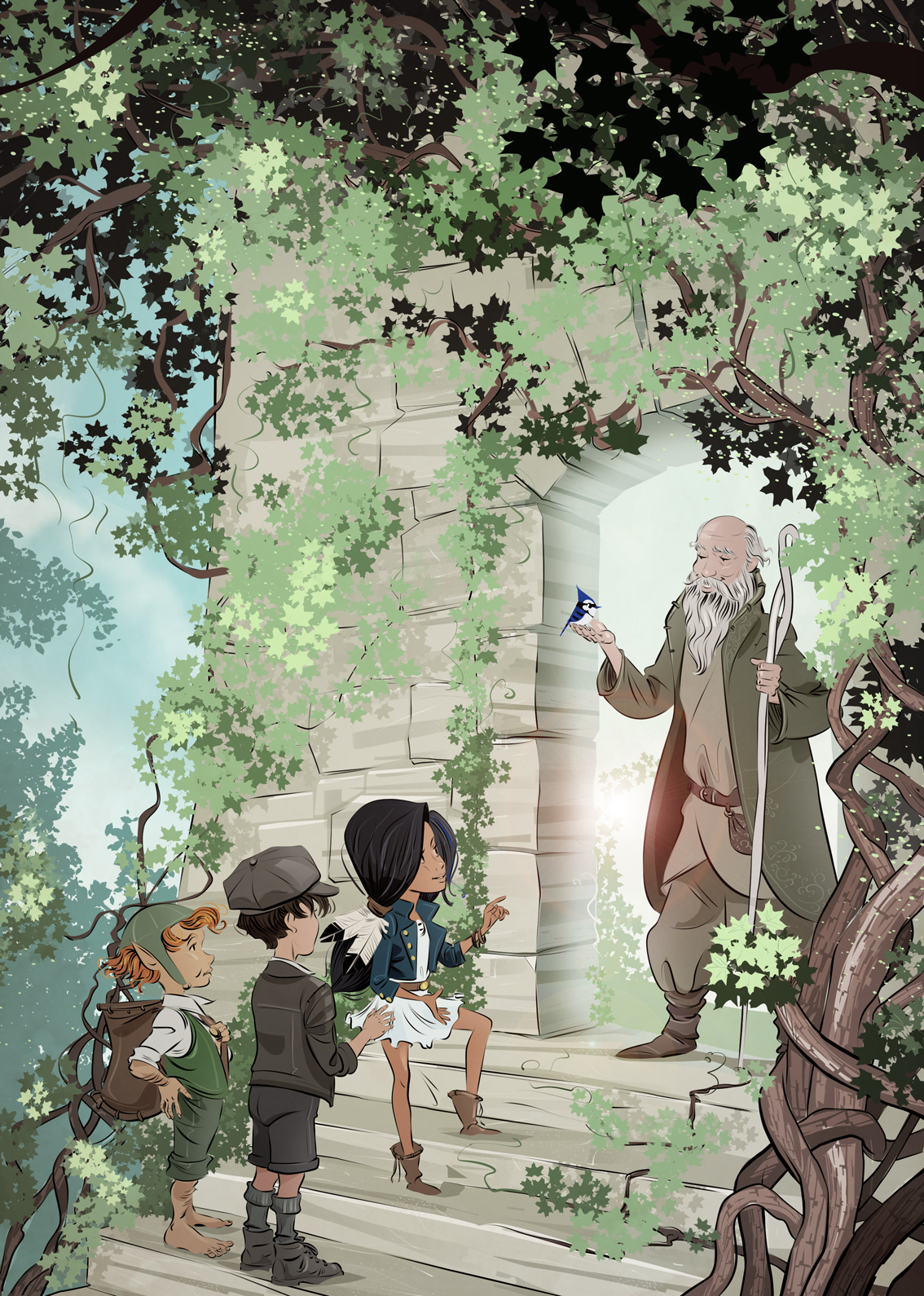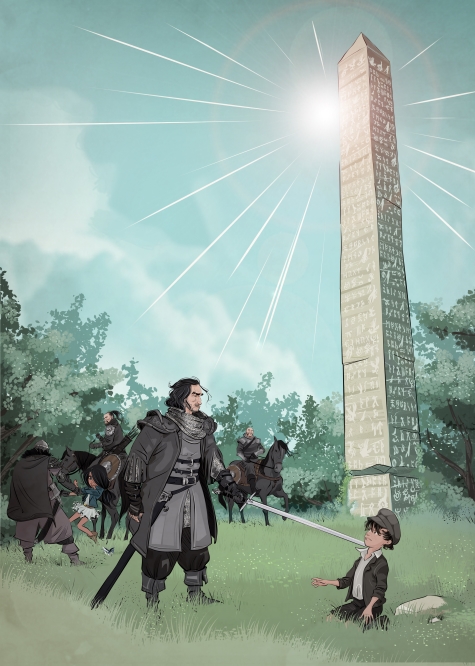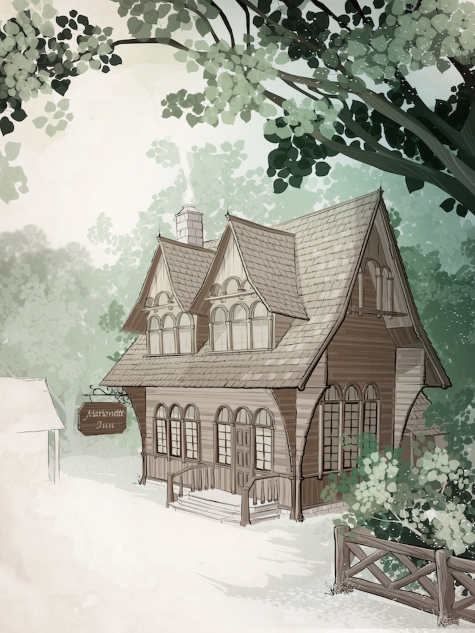Mapa
Kliknij złote pinezki, aby zobaczyć baśniowe miejsca z I i II tomu Central Park. Kraina Koe.

Green areas in the northern part of Central Park that are 23 acres wide. The shape resembles a butterfly and is a perfect place to relax and practice outdoor sports. Every winter, this area is closed to visitors to prepare a grassy area for re-use in the upcoming spring.
On the border between the Rustic Steppes and Emerald Fields, armies hostile to the Queen and the King meet each other, and this is where the final decision will be made – who will have a full control over the Land of Koe.
The fate of the magical world depends on the outcome of the battle.

Na drugim co do wielkości wzniesieniu w Central Parku (Vista Rock), pomiędzy przecinającą go ulicą 79 a stawem Turtle Pond, wzniesiono w 1869 roku zamek. Gmach zaprojektował jeden z twórców Central Parku – Calvert Vaux. Szary kamień, z którego zbudowano obiekt, to łupek wydobyty ze stawu podczas powstawania parku.
Nazwa zamku pochodzi z języka włoskiego i oznacza „piękny widok“, a sama budowla zapewnia spacerowiczom właśnie to, co obiecuje. Z jego dwóch balkonów roztacza się zjawiskowa panorama na najbardziej znane miejsca w parku: od strony północnej na Turtle Pond (Staw Żółwiowy) i położone za nim zielone tereny Great Lawn (nazywane Wielką Łąką), a od południa na puszczę.
Pierwotnie zamek był dostępną dla wszystkich parkową atrakcją pozbawioną drzwi i okien. Wiktoriańska, fantastyczna budowla o mocnej kamiennej fasadzie i masywnej wieży robiła na spacerowiczach duże wrażenie. Zmieniło się to w 1919 roku, gdy w gmachu zamku otwarto stację meteorologiczną, która znajdowała się tu aż do 1960 roku. Potem obiekt ulegał stopniowej dewastacji. Dopiero przeprowadzona w 1983 roku renowacja umożliwiła ponowne udostępnienie zamku zwiedzającym. Od 1992 roku mieści się tu stacja meteorologiczna oraz Centrum Naukowe Central Parku, w którym obejrzeć można wystawę lokalnej fauny i flory.
Stolica Królestwa wznosi się na wysokiej skale nad brzegiem Jeziora Żółwia. Miasto otaczają śnieżnobiałe mury bronione przez zastępy uzbrojonych po zęby rycerzy.
Widziana z góry przypomina wachlarz ze zbiegającymi się w jednym miejscu ulicami. Właśnie tutaj, na wielkim królewskim placu zlokalizowanym w pobliżu portu, skupia się życie stolicy. Odbywają się tu najważniejsze uroczystości, występy teatru i targ.
Nad miastem górują szare mury, a za nimi mieści się Zamek Belveder – siedziba Królowej, Królewska Akademia i Wielkie Archiwum.

On the second largest hill in Central Park (Vista Rock), between the Route 79 crossing it and the Turtle Lake, a castle was built in 1869. The building was designed by one of the creators of Central Park – Calvert Vaux. The gray stone from which the building was built, is a slate excavated from the pond during the formation of the park.
The name of the castle comes from the Italian language and means „”a beautiful view””, and the building itself provides the walkers with exactly what they were promised. From its two balconies, there is a phenomenal panorama of the most famous places in the park: from the north to the Turtle Lake and the green Great Lawn behind it, known as the Great Meadow, and from the south to the forest.”
Originally, the castle was accessible to everyone as a doorless and windowless park attraction. Victorian, fantastic building with a strong stone facade and a massive tower made a great impression on walkers. This changed in 1919, when a meteorological station was opened in the castle building, which was here until 1960. Then the object underwent gradual devastation. Only the renovation carried out in 1983 made it possible for the castle to be re-opened to the public. Since 1992, it has a meteorological station and the Central Park Science Center, where you can watch an exhibition of local fauna and flora.
The capital of the Kingdom rises on a high rock on the shore of the Turtle Lake. The city is surrounded by snow-white walls defended by armies of knights armed to the teeth.
Viewed from above, it resembles a fan with converging streets in one place. It is here, on the grand royal square near the port, that the life of the capital is focused. The most important celebrations, theater performances and market are held here.
Gray walls dominate the city, and behind them is the Belveder Castle – the Queen’s office, the Royal Academy and the Grand Archive.

Route 79 is one of the four streets intersecting the Central Park area. The main element distinguishing the successful Central Park development project by Frederick Law Olmsted and Calvert Vaux was the plan to lead them under the surface of the park.
The biggest obstacle in the construction of the Route 79 was Vista Rock – the second largest shale rock in Manhattan, on which – among others – Belvedere rises. Digging a tunnel under a rock was very difficult and expensive. It required the use of the most modern engineering knowledge and a large amount of gunpowder (dynamite was not known yet). The road construction was completed in 1861, and after thorough research, tunnels and bridges were considered safe and stable.
The Fog Gorge is an unexplored, deep canyon. No one has ever managed to reach the bottom hidden under the eternal fog. The gorge, like a huge deep scar, cuts the Land of Koe into two parts, disappearing in the Light Mountains on both sides of it. Only rope bridges overcome this obstacle.
The rope bridge near Belveder is in very poor condition. Only the bravest ones decide to defeat him. The crossing is guarded by the Queen’s soldiers stationed in a military stronghold, as neglected as a bridge.

A two-level terrace designed by Calvert Vaux, considered the heart of Central Park. In the center there is a fountain called the Water Angel, which commemorates the opening in 1842 of the first clean water providing system in New York.
It was built by Helion, who was impressed by the artists’ lifestyle. The life of full liberty and unlimited freedom, created for the people of art, their needs and values. It’s a place born out of dreams of a friendly space in which musicians, dancers, actors and other representatives the world of culture, can develop their talents.

The Shakespearean Garden is an area in Central Park named after an English poet and playwright. Picturesque park alleys are planted with plants that appear in the master’s words. Small bronze plates scattered throughout the garden contain quotes from the poet’s works.
The garden was established in 1880 on the initiative of the commissioner of the park, George Clausen. He asked the entomologist of the park to develop the space around the then center of nature research, located in today’s Puppet Theater. In 1913, this space was officially named by the English poet.
Dorian Forest is not the largest in the Kingdom of Koe, but there are circulating tales about its most winding, mysterious paths and unusual inhabitants. Malicious gnomes, wild creatures and living trees lurking for carefree travelers, hijack travelers to a magical, fragrant garden full of unusual flowers. Their fragrance made the lost unfortunates to lose their memory and by the end of their days they wandered along the winding paths of the forest.
From the south to the north of the Kingdom there’s a route through the Dorian Forest, leading through the only bridge in this area. It connects eastern and western routes, running along the ravine and leading to the capital of the Kingdom – Belvedere.

The Metropolitan Museum of Art in New York is the oldest and largest museum in the United States and at the same time the most-visited place in New York (about 5 million visitors a year). In the area of 190 thousand sq m, over 2 million works were collected and all of them are works of legendary artists.
The museum is located on the eastern edge of Central Park on Fifth Avenue. It was founded in 1870. They were moved to the present building 10 years after its creation. Thanks to numerous donations, it constantly grows with new collections and exhibits. There are unique collections of paintings, decorative art and huge collections of sculptures and monuments from all ages and sides of the world. The museum also boasts collections of complete rooms, rooms and courtyards.
Visiting this huge collection requires a lot of time and a detailed sightseeing plan, so that in the labyrinth of rooms, courtyards and galleries you will not miss the greatest treasures of the museum.
The Stone Forest is a natural rock labyrinth, located on the eastern boundaries of Koe, with the Fog Gorge from the south, and from the west it is separated from the land of the Eastern Route.
The high, towering rocks resemble stone statues, and the walk between them is like a wandering between tall trees. After a few minutes it is difficult to find the way back. Rising high rock columns make it impossible to orientate in space and make the travelers still return to the same places.
Deep in the heart of the labyrinth is hidden the dark castle of the Evil Lord.

The whole Manhattan Island, on which Central Park is located, is a hard granite rock. Thanks to the unusual geological structure of this area, it was possible to create a place with the world’s largest concentration of skyscrapers per square meter.
Granite mountains rise on the southeastern edge of Land of Koe. Big stone blocks, stacked one above the other, form a wall of stones overgrown with clusters of wild bushes. It is here, where the treasure-towers are hidden.
There are many stories about the treasures that are inside the granite massif. At its foot, there are constant searches to enter the cave leading to the Helion Mines hidden here. For this reason, the forest growing on the slope has been cut. From everywhere you can see the piles of branches, uprooted roots or broken trunks.

The facility is located in the northern part of Central Park. In summer, it is used as a swimming pool, while in the winter it plays the role of an ice rink for ice skating and hockey.
The headquarters of the King and at the same time – a real fortress. On the one hand, guarded by large, thick walls, and on the other surrounded by a white surface of frozen lake. Due to the unique location, nobody has dared to attack the castle yet. Therefore, it becomes a convenient place for the gathering of the King’s army.

Mały fort zlokalizowany w północnej części Central Parku. Ukończony w 1814 roku jest jednym z trzech umocnień tego typu na Manhattanie, które powstało w wyniku wojny z Anglią (1812 rok). Istnieją jednak teorie, według których powstał wcześniej, jeszcze w czasie rewolucji amerykańskiej.
Otoczona zieloną gęstwiną siedziba maga ziemi – Trezatena. Wygląda na zaniedbaną i porzuconą. Jej ściany porasta dzikie wino, a pnącza oplatają budynek gęstą siecią. Tutaj kamień i roślnność stanowi jedność, której nic nie jest w stanie rozdzielić.

The zoological garden, built in 1864 as a menagerie, is the first official zoo opened in New York. In 1934, new facilities were built on its territory to give it its present appearance.
The Winboo headquarters – the king of the Kingdom of Animals – is an inconspicuous building of red brick. The main courtyard with a small pond is surrounded by low red walls and arcades finished with arches. The chambers in the castle were arranged so that they would be comfortable for the animals living here.
The castle guard, armed to the teeth, patrols the area surrounding the headquarters of the King of animals, going mercilessly with all those who would like to hurt the inhabitants of the capital and the ruler himself.

Cała wyspa Manhattan, na której leży Central Park, to twarda granitowa skała. Dzięki niezwykłej budowie geologicznej tego terenu możliwe było stworzenie miejsca o największej na świecie koncentracji drapaczy chmur na metr kwadratowy.
Granitowe góry wznoszą się na południowo-wschodnim krańcu Krainy Koe. Wielkie kamienne bloki, poukładane jeden nad drugim, tworzą ścianę kamieni porośniętych kępami dzikich krzaków. Tutaj właśnie ukryte są kopalnie pełne skarbów.
O skarbach, które znajdują się we wnętrzu granitowego masywu, krąży wiele opowieści. U jego podnóża nieustannie trwają poszukiwania wejść do jaskini prowadzących do ukrytych tu Kopalni Heliona. Z tego względu porastający zbocza las został poddany wycince. Zewsząd dostrzegalne są sterty gałęzi, wyrwane z ziemi korzenie czy połamane pnie.

Ogród zoologiczny zbudowany w 1864 roku jako menażeria to pierwsze oficjalne zoo otwarte w Nowym Jorku. W 1934 roku na jego terenie wybudowano nowe obiekty, które dają mu obecny wygląd.
Siedziba Winboo – władcy Królestwa Zwierząt. Przybywających tu podróżnych wita widok niskich, niepozornych zabudowań z czerwonej cegły. Główny dziedziniec z niewielką sadzawką otaczają niewysokie mury i arkady. Wszystkie komnaty w zamku urządzono skromnie, lecz wygodnie dla mieszkających tu zwierząt.
Uzbrojona po zęby straż zamkowa bezustannie patrololuje tereny okalające siedzibę króla zwierząt, obchodząc się bezlitośnie z wszystkimi, którzy chcieliby skrzywdzić mieszkańców stolicy i samego władcę.

Obiekt zlokalizowany w północnej części Central Parku. Latem używany jako basen, natomiast zimą wciela się w rolę lodowiska do jazdy na łyżwach oraz uprawiania hokeja.
Siedziba króla i jednocześnie prawdziwa twierdza. Z jednej strony strzeżona przez wielkie, grube mury, a z drugiej otoczona białą taflą zamarzniętego jeziora. Ze względu na wyjątkowe położenie nikt dotąd nie odważył się zaatakować zamku. Dlatego też staje się dogodnym miejscem dla zgromadzenia armii króla.

The Swedish house is the headquarters of one of the public puppet theaters in the United States and has been operating since 1947. The cottage, which was constructed as a model of a school building, was presented in Philadelphia in 1876 during the first World Exhibition in the USA. After the event, the main architect of the park Frederick Law Olmsted brought a rustic building to Central Park. It was used in a variety of ways. Among others, there was a center for nature study for children and entomological laboratories.
On the meadow hidden in the forest, the Marionette Inn is surrounded by a low wall, a dark-log house with a pointed roof decorated with arched doors and arcades above the balconies. Next to the Inn, there is a stable and several small houses hidden in the shade of trees and colorful waggons of the acting troupe. The Inn is not that impressive. It owes its recognition throughout the Land of Koe to the excellent cuisine and extremely interesting form of the host – the precursor of fashion and style, as well as a reliable source of information from the entire Kingdom.

Dwupoziomowy taras zaprojektowany przez Calverta Vaux, uznawany za serce nowojorskiego Central Parku. W centralnym punkcie obiektu znajduje się fontanna zwana Aniołem Wód, która upamiętnia otwarcie w 1842 roku pierwszego systemu dostarczającego czystą wodę w Nowym Jorku.
Zbudowane przez Heliona, który pozostawał pod wrażeniem stylu życia artystów. Życia pełnego wolności i nieograniczonej swobody. Powstało z myślą o ludziach sztuki, ich potrzebach i wartościach. Miejsce zrodzone z marzeń o przyjaznej przestrzeni, w której muzycy, tancerze, aktorzy i inni przedstawiciele świata kultury mogą rozwijać swoje talenty.

Droga 79 jest jedną z czterech ulic przecinających teren Central Parku. Głównym elementem wyróżniającym zwycięski projekt zagospodarowania Central Parku autorstwa Fredericka Law Olmsteda i Calverta Vaux był plan poprowadzenia ich pod powierzchnią parku.
Największą przeszkodą w budowie drogi 79 okazała się Vista Rock- druga co do wielkości skała łupkowa na Manhattanie, na której wznosi się między innymi Belvedere. Wykopanie tunelu pod skałą było bardzo trudne i kosztowne. Wymagało zastosowania najnowocześniejszej wówczas wiedzy inżynieryjnej i sporej ilości prochu (dynamit nie był jeszcze znany). Budowę drogi zakończono w 1861 roku, a po przeprowadzeniu starannych badań tunele i mosty uznano za bezpieczne i stabilne.
Wąwóz Mgieł to niezbadany, głęboki kanion. Nikomu nigdy nie udało się dotrzeć do ukrytego pod wieczną mgłą dna. Wąwóz niczym wielka głęboka blizna rozcina Krainę Koe na dwie części, ginąc w Górach Świetlistych po obu jej stronach. Jedynie linowe mosty pozwalają pokonać tę przeszkodę.
Most linowy w okolicy Belvederu jest w bardzo złym stanie. Na pokonanie go decydują się tylko najodważniejsi. Przeprawy strzegą żołnierze Królowej stacjonujący w wojskowej warowni, równie zaniedbanej jak most.

The Naturalists’ Walk is located opposite the Museum of Natural History. Before 1996 this area was seen as wild, neglected and even dangerous. After the restoration of the paths, the place became a favorite walking route for people visiting the nearby museum. The atmosphere seems almost magical, especially when the city’s paths enter the city’s hustle and bustle, which are decorated with rustic benches, next to which the lawn invites to rest.
Half a day away from the portal, there is a gnomes village, where straw-covered cottages surround a small square. Each of them has a low fence giving off a small garden filled with colorful flowers, fruit trees or even patches. The most important place of the settlement is the giant Oak, a shade that is thrown by it, hides a clearing full of tangled roots, with a tiny oak house in which the tree keeper resides.The oak tree is a treasure of gnomes. For centuries, they have been using the riches that it supplies, producing the famous the entire land of zarratt spice and a lot of various ointments and specifics of the most bizarre destiny and properties.

Ścieżka Przyrodników położona jest naprzeciwko Muzeum Historii Naturalnej. Przed 1996 rokiem teren ten postrzegany był jako dziki, zaniedbany, a nawet niebezpieczny. Po odrestaurowaniu ścieżek miejsce stało się ulubionym szlakiem spacerowym osób odwiedzających pobliskie muzeum. Zacieniony krajobraz zaskakuje kolorami i kształtami. Towarzysząca mu zaciszna atmosfera wydaje się niemal magiczna, szczególnie gdy na parkowe ścieżki wkracza się ze świata miejskiego zgiełku. Te zaś przyozdobione są rustykalnymi ławkami, obok których rozciąga się zachęcający do wypoczynku trawnik.
Pół dnia drogi od portalu znajduje się wioska gnomów, gdzie kryte słomianą strzechą domki otaczają mały placyk. Każdy z nich posiada niski płot wydzielający niewielki ogródek wypełniony barwnymi kwiatami, drzewami owocowymi lub równiutkimi grządkami. Wielobarwne domki są zdobione rysunkami, ornamentami lub porasta je dzikie wino. Najważniejszym miejscem osady jest olbrzymi Dąb. Cień przez niego rzucany skrywa polanę pełną splątanych korzeni. Stoi na niej maleńki Dębowy Domek, w którym mieszka opiekun drzewa. Dąb jest skarbem gnomów. Od wieków korzystają one z bogactw, które dostarcza, wytwarzając słynną w całej krainie przyprawę zarrattę oraz mnóstwo rozmaitej maści i specyfików o najdziwniejszym przeznaczeniu oraz właściwościach.

It’s a part of one of the streets intersecting Central Park, which runs nearby The Metropolitan Museum of Art and leads towards the American Museum of Natural History.
At the exit from the labyrinth, between the stone pillars and the Fog Gorge, there are green meadows gently sloping towards the abyss. This is where the wide Eastern Route ends. The remains of the rope bridge destroyed many years ago hang on the walls of the ravine, and the remaining stone structure protrudes on both sides. The monotony of the green-gray landscape is interrupted only by a building with an inclined roof, located on a small hill, surrounded by a garden.

One of the most picturesque corners of Central Park. This large water reservoir was built in the 1860s as a temporary reservoir securing water supplies for residents of New York.
It is located on the northern shore of the Central Sea dividing the Land of Koe into two parts. A camp and a place of concentration of the entire Queen’s fleet. The ships assembled there expect a signal to make their way to the opponents meeting from the South, and demonstrate the enormity of power available to the ruler.

Zielone tereny w północnej części Central Parku liczące 23 akry. Kształtem przypominają motyla i stanowią doskonałe miejsce do wypoczynku oraz uprawiania sportu na otwartym powietrzu. Każdej zimy obszar ten jest zamykany dla odwiedzających, by przygotować trawiastą powierzchnię do ponownego użytku już w czasie nadchodzącej wiosny.
Na pograniczu Rdzawych Stepów i Szmaragdowych Pól spotykają się armie wrogo do siebie nastawionych Królowej i Króla. To tu właśnie ma dojść do ostatecznego rozstrzygnięcia, kto przejmie pełnię władzy nad Krainą Koe. Od wyniku bitwy zależą dalsze losy magicznego świata.

The Eaglevale Bridge is the only double arch in Central Park, connecting 77th Street with West Drive, stretched over a horseback path and a pedestrian path.
The pedestrian path was originally a narrow branch of the lake Lake flowing from under the Balcony Bridge. It fells into the Ladies Pond, dried in 1936 and turned into a playground, which is still today. The former reservoir turned into a small stream flowing into the Lake.
Built in 1890, the arch under 77th Street separates the natural walking paths – Naturalists’ Walk and Azalea Walk. Eaglevale Bridge has a length of 46 and a width of about 11 meters. However, the height of arches is slightly above 4 and 5.5 meters, and their width oscillates around 10 meters.
Only a few know that the gray stone wall under the arch of the bridge located in Central Park is part of the magic portal – one of the few places through which one can get to the Kingdom of Koe.
The stone guards watch the portals, being present on both sides at the same time. In Central Park they are part of a stone building, and in Land of Koe they guard access to the outside world.
The portal under the Eaglevale bridge, guarded by Stabin, is an entrance to the arch of a narrow stone gorge in the Kingdom of Koe, in which the mirror surface of the portal glitters.

Most Eaglevale jest jedynym podwójnym łukiem w Central Parku. Łączy ulicę 77 z West Drive, rozpościerając się nad ścieżką do jazdy konnej oraz ścieżką dla pieszych.
Ścieżka dla pieszych pierwotnie była wąską odnogą jeziora Lake wypływającą spod Balcony Bridge. Wpadała do Lodowiska dla Pań (Ladies Pond), osuszonego w 1936 roku i zamienionego w plac zabaw, którym jest do dzisiaj. Dawny zbiornik wodny zamienił się w niewielki strumień wpadający do jeziora Lake.
Wybudowany w 1890 roku łuk pod ulicą 77 oddziela od siebie ścieżki spacerowe Naturalists’ Walk (Ścieżka Przyrodników) i Azalea Walk (Ścieżka Azaliowa). Eaglevale Bridge ma długość 46 i szerokość około 11 metrów. Natomiast wysokość łuków wynosi nieco powyżej 4 oraz 5,5 metra, zaś ich szerokość oscyluje wokół 10 metrów.
Tylko nieliczni wiedzą, że szara kamienna ściana pod łukiem mostu znajdującego się w Central Parku to część magicznego portalu – jedno z kilku miejsc, dzięki którym można dostać się do Królestwa Koe.
Kamienni strażnicy pilnują portali, będąc obecnymi po ich obu stronach jednocześnie. W Central Parku są częścią kamiennej budowli, a w Koe strzegą dostępu do świata zewnętrznego.
Portal pod mostem Eaglevale, którego strzeże Stabin, to w Królestwie Koe wejście do spiętego łukiem wąskiego kamiennego wąwozu, w którym połyskuje lustrzana tafla portalu.

A monument in honor of 266 sailors who died in 1898 due to the explosion of the battleship Maine, a gold-plated bronze figure mounted on the top of the pylon depicts Columbia.The personified figure of the homeland stands on a shell chariot drawn by three hippocamps (in Greek and Roman mythology half-horses, half fish, with a pair of horse legs).
Among the dark granite peaks stretching on the south-western edge of the Land of Koe emerges Rock of Winds. Its slender, shining silhouette in the sun grows above other peaks of the Luminous Mountains.
Legends say that a seaman looking for a treasure has come here once. When he reached the rock exhausted by the journey, he sat at the foot of it and fell asleep. The dream in which he fell was so beautiful that he wished he would never wake up. And that’s what happened. The body of a sailor plunged into eternal sleep turned to stone. Since then, it has been said that the Rock of the Winds never releases those who have stopped at it.
Few know that the top of the Rock of Winds is the home of the Air Mage and his unusual hippocampus.

The youngest building in Central Park. Built in 1993, it offers free education and community programs for city residents.
A small, unfinished brick building with rough walls, located on the shore of the lake. It is here that children from all over the kingdom were to learn the secrets of nature and the world around them. The headquarters of Erades, the water mage, who decided to complete the creation of the school, abandoned a few years earlier by the wise men of Koe.

Ogród Szekspirowski to obszar w Central Parku nazwany na cześć angielskiego poety i dramaturga. Malownicze parkowe alejki obsadzono roślinami, które pojawiają się w utworach mistrza słowa. Małe tabliczki z brązu rozproszone po całym ogrodzie zawierają cytaty z dzieł poety.
Ogród powstał w 1880 roku z inicjatywy komisarza parku Georga Clausena. Poprosił on entomologa parku o zagospodarowanie przestrzeni wokół ówczesnego centrum badania przyrody, mieszczącego się w dzisiejszym Teatrze Marionetek. W 1913 roku przestrzeń ta została oficjalnie obwołana nazwiskiem angielskiego poety.
Doriańska Puszcza nie jest największą w Królestwie Koe, ale o jej krętych, tajemniczych ścieżkach i niezwykłych mieszkańcach krąży najwięcej opowieści. Złośliwe skrzaty, dzikie stwory i żywe drzewa, czyhające na beztroskich podróżnych, porywały wędrowców do magicznego, wonnego ogrodu, pełnego niezwykłych kwiatów. Ich zapach sprawiał, że zagubieni nieszczęśnicy tracili pamięć i do końca swych dni błądzili po krętych ścieżkach puszczy.
Przez Doriańską Puszczę wiedzie trakt z południa na północ królestwa, prowadząc przez jedyny w tej okolicy most. Łączy on szlaki wschodni z zachodnim, biegnąc wzdłuż wąwozu i prowadząc do stolicy królestwa Belvederu.

Pomnik ku czci 266 marynarzy, którzy zginęli w 1898 roku wskutek wybuchu pancernika Maine. Złocona figura z brązu osadzona na szczycie pylonu przedstawia Columbię. Upersonifikowana postać ojczyzny stoi na rydwanie z muszli ciągniętym przez trzy hippokampy (w mitologii greckiej i rzymskiej pół konie, pół ryby, z parą końskich nóg).
Spośród ciemnych granitowych szczytów rozciągających się na południowo-zachodnim skraju Krainy Koe wyłania się Skała Wichrów. Jej smukła, jaśniejąca w słońcu sylwetka wyrasta ponad inne wierzchołki Gór Świetlistych.
Jak mówią legendy, przybył tu kiedyś marynarz szukający skarbu. Gdy dotarł do skały wyczerpany wędrówką, usiadł u jej podnóża i zasnął. Sen, w który zapadł, był tak piękny, że zapragnął nigdy się nie obudzić. I tak się właśnie stało. Ciało marynarza pogrążonego w wiecznym śnie zamieniło się w kamień. Od tego czasu mówi się, że Skała Wichrów nigdy nie wypuszcza tych, którzy się przy niej zatrzymali.
Niewielu wie, że wierzchołek Skały Wichrów to dom Maga Powietrza i jego niezwykłych hippokampów.

Część jednej z ulic przecinających Central Park, która przebiega opodal The Metropolitan Museum Of Art i prowadzi w stronę Amerykańskiego Muzeum Historii Naturalnej.
U wyjścia z labiryntu, między kamiennymi słupami a Wąwozem Mgieł, znajdują się zielone łąki łagodnie opadające w kierunku przepaści. To tutaj kończy się szeroki Trakt Wschodni. Resztki zniszczonego przed wieloma laty linowego mostu wiszą na ścianach wąwozu, a na obu jego brzegach sterczą pozostające kamiennej konstrukcji. Monotonię zielono-szarego krajobrazu przerywa jedynie położony na niewielkim wzniesieniu budynek o skośnym dachu, otoczony ogrodem.

Jeden z najbardziej malowniczych zakątków Central Parku. Ten duży zbiornik wodny został zbudowany w latach 60. XIX wieku jako tymczasowy rezerwuar zabezpieczający dostawy wody dla mieszkańców Nowego Jorku.
Położony jest na północnym brzegu Morza Środkowego dzielącego Krainę Koe na dwie części. Obóz i miejsce koncentracji całej floty należącej do królowej. Zgromadzone tam okręty oczekują na sygnał, by ruszyć na spotkanie przeciwników z Południa, i demonstrują ogrom sił, jakimi dysponuje władczyni.

A small fort located in the northern part of Central Park. Completed in 1814, it is one of the three fortifications of this type in Manhattan, which was created as a result of the war with England (1812). However, there are theories, according to which it was created earlier, during the American Revolution.
Surrounded by a green thicket, the abode of the ground’s mage – Trezaten. It looks neglected and abandoned, its walls are covered with wild wine, and the climbers cling to the building with a dense net. Here stone and plants are a unity that nothing can separate.

The Egyptian obelisk called Cleopatra’s Needles in Central Park is one of two twin monuments erected in times of Tutankhamon III in the XV century BC. Pharaoh commissioned their construction to celebrate 30 years of his reign. In the XXIII or XXII century BC, both obelisks were moved to Alexandria where they stood in front of the Caesar’s temple.
In the XIX century, the Egyptian government led by Muhammed Ali – the viceroy of Egypt – donated obelisks to Europe and the United States. The lying obelisk, height of nearly 22 meters and weight of 220 tons, was transported to the United Kingdom in 1877/78. This was done by a barge constructed specially for this purpose. The obelisk stood on the banks of the Thames in London.
The 21.60-meter high obelisk set off in 1880 to the USA. To transport a 220-ton giant, a special submarine-like container was constructed, which was towed by ships to New York. It still stands in Central Park, where in 1882 it was given special protection due to the destruction caused by the winter weather.
The obelisk is the oldest work of human hands in Central Park and the oldest monument in the whole New York City. The extensive restoration of the monument, carried out in 1989, exposed numerous hieroglyphs on the granite surface, which were covered with the layers of dust and dirt created for thousands of years.
The soaring spire of the Sunny Stone rises above the crowns of trees in the forest surrounding the Turtle Lake from the north.
The entire surface of the stone obelisk is covered with strange, incomprehensible signs. They writhe around, arrange into various scenes, and in some places they disappear blurred by time.
Nobody can read the signs. No one knows how old the obelisk is. Legends say that every year, when the day and night are aligned, the stone receives a new guardian – Lady of the Stone, who for the next 365 days also becomes the Lady of the Night in the whole Land of Koe, and then another sign appears on the stone.

Najmłodszy budynek w Central Parku. Zbudowany w 1993 roku oferuje bezpłatną edukację i programy wspólnotowe dla mieszkańców miasta.
Niewielki, niedokończony murowany budynek o surowych ścianach, usytuowany nad brzegiem jeziora. To tutaj dzieci z całego królestwa miały poznawać sekrety przyrody i otaczającego je świata. Siedziba Eradesa, maga wody, który postanowił dokończyć dzieło tworzenia szkoły zarzucone kilka lat wcześniej przez mędrców Krainy Koe.

Stojący w Central Parku egipski obelisk nazywany Szpilą Kleopatry jest jednym z dwóch bliźniaczych monumentów wzniesionych za czasów przez Tutenhamona III w XV wieku p.n.e. Faraon zlecił ich budowę, by uczcić 30 lat swego panowania. W XXIII lub XXII wieku przed Chrystusem udało się przenieść oba obeliski do Aleksandrii gdzie stanęły przed świątynią Cezara. i.
W XIX wieku rząd egipski pod kierownictwem Muhammeda Aliego – wicekróla Egiptu – podarował obeliski Europie i Stanom Zjednoczonym. Leżący obelisk o wysokości blisko 22 metrów i ciężarze 220 ton przetransportowano w latach 1877/78 do Wielkiej Brytanii. Dokonano tego specjalnie skonstruowaną w tym celu morską barką. Obelisk stanął na brzegu Tamizy w Londynie.
Stojący obelisk o wysokości 21,60 metrów wyruszył w 1880 roku do USA. Do przetransportowania 220 tonowego giganta skonstruowano specjalny, przypominający łódź podwodną pojemnik, który holowano statkami do Nowego Jorku. Stoi do dziś w Central Parku, gdzie w 1882 roku został objęty szczególną ochroną ze względu na zniszczenia, które powodowała zimowa aura.
Obelisk jest najstarszym dziełem rąk ludzkich w Central Parku i najstarszym zabytkiem w całym Nowym Jorku. Przeprowadzona w 1989 roku gruntowna restauracja pomnika odsłoniła na granitowej powierzchni liczne hieroglify, które pokrywały tworzące się przez tysiące lat warstwy kurzu i brudu.
Strzelista iglica Słonecznego Kamienia wznosi się ponad korony drzew w otaczającym od północy Jezioro Żółwia lesie.
Całą powierzchnię kamiennego obelisku pokrywają dziwne, niezrozumiałe znaki. Wiją się wokół, układają w rozmaite sceny, a w niektórych miejscach znikają zatarte przez czas.
Nikt nie potrafi odczytać znaków. Nikt nie wie też, jak stary jest obelisk. Legendy mówią, że co roku, kiedy następuje zrównanie dnia z nocą, kamień otrzymuje nowa opiekunkę – Panią Kamienia, która na następne 365 dni staje się również Panią Nocy w całym Koe, a na kamieniu pojawia się wówczas kolejny znak.

The Metropolitan Museum of Art w Nowym Jorku to najstarsze oraz największe muzeum w Stanach Zjednoczonych i jednocześnie najchętniej odwiedzane miejsce w Nowym Jorku (około 5 mln gości rocznie). Na obszarze 190 tys. m kw. zgromadzono przeszło 2 mln prac i wszystkie z nich to dzieła legendarnych twórców.
Muzeum znajduje się na wschodnim skraju Central Parku przy Piątej Alei. Zostało założone w 1870 roku. Do obecnego budynku przeniesiono je 10 lat po jego powstaniu. Dzięki licznym darowiznom rozrasta się nieustannie o nowe kolekcje i eksponaty. Znajdują się tu unikalne zbiory malarstwa, dzieł sztuki zdobniczej i ogromne zbiory rzeźb oraz monumentów ze wszystkich epok i stron świata. Muzeum szczyci się także kolekcjami kompletnych pomieszczeń, pokoi oraz dziedzińców.
Zwiedzenie tej ogromnej kolekcji wymaga dużego nakładu czasu i dokładnego planu zwiedzania, tak by w labiryncie sal, dziedzińców i krużganków nie przeoczyć największych skarbów muzeum.
Las Kamiennych postaci jest naturalnym skalnym labiryntem. Znajduje się na wschodnich rubieżach Koe. Od południa graniczy z Wąwozem Mgieł, a od zachodu odgradza go od krainy Trakt Wschodni.
Wysokie, strzeliste skały przypominają kamienne posągi, a spacer między nimi jest jak wędrówka między wysokimi drzewami. Już po kilku minutach trudno odnaleźć drogę powrotną. Wznoszące się wysoko skalne słupy uniemożliwiają orientowanie się w przestrzeni i sprawiają, że wędrowcy wciąż wracają w te same miejsca.
Głęboko w sercu labirynu ukrywa się mroczny zamek Złego Pana.

Szwedzki domek jest siedzibą jednego z publicznych teatrów marionetek w Stanach Zjednoczonych i działa od 1947 roku. Domek, który skonstruowano jako model budynku szkolnego, został zaprezentowany w Filadelfii w 1876 roku podczas pierwszej Wystawy Światowej w USA. Po zakończeniu wydarzenia główny architekt parku Frederick Law Olmsted sprowadził rustykalny budynek do Central Parku. Wykorzystywany był w najróżniejszy sposób. Znajdowało się tu między innymi centrum badania przyrody dla dzieci i laboratoriom entomologiczne.
Na ukrytej w lesie polanie stoi otoczony niewysokim murkiem Zajazd Marionetek. Dom z ciemnych bali o spiczastym dachu zdobią wykończone łukiem drzwi i arkady nad balkonami. Obok zajazdu znajduje się stajnia i kilka małych domków ukrytych w cieniu drzew oraz kolorowe wozy aktorskiej trupy. Zajazd nie jest okazały. Swoją rozpoznawalność w całej Krainie Koe zawdzięcza znakomitej kuchni oraz niezwykle ciekawej postaci gospodarza Jowiatana – prekursora mody i stylu, a także wiarygodnego źródła informacji z całego królestwa.





